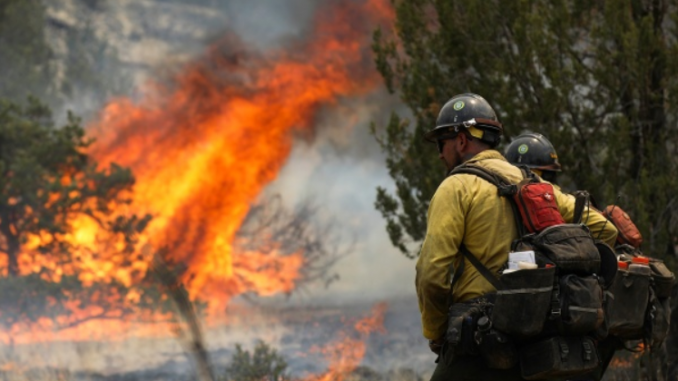
A fire in northern Arizona has burned more than 26,500 acres — over 41 square miles — in an area north of Flagstaff, according to Coconino National Forest officials.
While the cause of the fire (at 50% containment) has yet to be determined, a man has reportedly been arrested in connection to the incident, on charges of natural resource violations.
Citing a report from The Arizona Republic, approximately 750 work crews have been tasked with containing the wildfire along the area’s northern edge — a challenge made more difficult by the lack of precipitation in recent days.
Steep terrain on the western edge of the blaze has also made firefighting efforts difficult.
In a Monday news release, Coconino National Forest officials said:
“Recent precipitation and fire suppression actions — including improving and strengthening uncontained fireline, detecting and extinguishing hotspots and diligent monitoring — have helped firefighters gain further containment on the northern edge of the fire.
“Due to the recent advance in containment, efforts will be transitioning to suppression repair activities, and firefighters are removing unneeded equipment from the containment lines.
“While containment continues to increase, fire managers are confident in the status of containment and will start to release firefighter and aviation assets today to ‘right size’ assigned resources.”
The wildfires have increased awareness to the richness and resiliency of this remote land, which features ancient burial sites, ancient tools and artifacts, and dwellings that have endured centuries of atmospheric and man-made changes.
According to The Associated Press:
- Last week, a handful of archaeologists located a semi-buried dwelling, or “pit house,” which traces back more than 1,000 years.
- Multilevel stone homes, rock carvings and pieces of clay and ceramic pots that have been well preserved in the arid climate — “long before fire suppression became a tactic.”
- The nearby Wupatki National Monument — a center of trade for Indigenous communities around the 1100s — has exhibits of priceless objects, including 800-year-old corn, beans and squash, “along with intact Clovis points, or stone arrowheads, that date back some 13,000 years.”
The monument has some 2,600 archaeological sites across 54 square miles (141 square kilometers), representing a merging of cultures on the Colorado Plateau in the Four Corners — where New Mexico, Arizona, Colorado and Utah famously converge at one spot.
The region includes the Grand Canyon, the Painted Desert, Hopi mesas, volcanic cinder fields, the largest contiguous ponderosa pine forest in the U.S., and the San Francisco Peaks — a mountain range that is sacred to 13 Native American tribes.
The area ”has been burned many, many times, and that’s healthy,” said Jason Nez, a Navajo archaeologist and firefighter. “A lot of our cultural resources we see as living, and living things are resilient.”
Nez added: “Some of those arrowheads, some of those pottery sherds [broken ceramics] you see out there have that power to change the way we look at how humans were here.”
Coconino National Forest on the southern edge of the plateau has surveyed just 20% of its 2,900 square miles (7,510 square kilometers) and logged 11,000 archaeological sites, according to Jeanne Stevens, a U.S. Forest Service archaeologist and tribal relations specialist.
Forest restoration work that includes mechanical thinning and prescribed burns has “given archaeologists an opportunity to map sites and log items.”
More discoveries are expected because of the wildfires, especially in the more remote areas, Stevens said.
Via Newsmax
